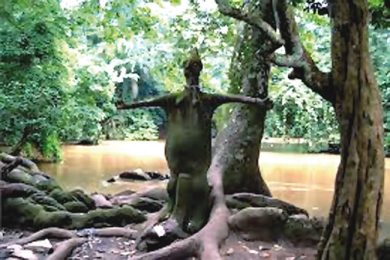By Adedokun Feyikemi Adebola
July 17, 2024
OSUN Osogbo sacred grove is among the last of the sacred forests which can be found on the edges of Yoruba cities before extensive urbanisation.
The grove, which was made a UNESCO World Heritage Site in 2005, has contributed to the socio-cultural changes in Osogbo and its environs.
Many people in the community, particularly traders and other business operators rely on the grove to thrive economically.
The grove is blessed with sacred water which is spiritual and it is considered a perfect destination for ecotourism because of the spiritual importance of the water.
However, the grove witnesses a lot of disasters brought about as a result of human or natural disasters.
It must be noted that Osogbo people have expanded to the surrounding areas of the grove and their activities are already spelling doom for the sacred water, which is expected to be kept pure.
Also, the road which links the grove to the other parts of the town carries significant daily traffic with passersby leaving litters, dropping cigarette stubs, among others, which have led to fire disasters in the Grove’s forests on several occasions.
At the buffer zone of the grove, farms are being cultivated and every year, farmers keep encroaching on the forests.
There also those who illegally harvest plants in the grove for medical purposes and other uses.
Preservation, conservation and protection of the grove are carried out with the use of taboos, rituals dedicating the forest to the deities as well with the activities of the government officials and the grove guards.
The local communities, priests and traditionalists play significant roles towards the preservation and conservation of the grove from unauthorised users and all forms of disasters.
Protection, conservation and management of the grove are carried out at four different levels, the first is the traditional institution, which includes the Ataoja of Osogbo land, traditional chiefs in council, priests and priestesses of Osun Grove, Aworo Osun, Ifa practitioners, priests and priestesses of other shrines etc.
The second group is the non-governmental organisations which include Adunni Olorisa Trust, Association of Tourism Practitioners of Nigeria, etc, the third category are government institutions, which include National Commission for Museums and Monuments (NCMM), UNESCO, National Orientation Agency (NOA), National Gallery, National Council for Arts and Culture and others which include secondary schools, and students, universities like the Obafemi Awolowo University (OAU), Fountain University, Osun State University, among others, Africans in the diaspora, tourists and tour operators.
Though being managed through multi-dimensional layers, the managers have their tasks and responsibilities, which are in line with UNESCO guidelines for world heritage sites.
The National Commission for Museums and Monuments (NCMM), for example, is charged with the responsibility of promoting adequate staff that will ensure full control, protection and conservation of the site, while the Nigeria Tourism Development Corporation (NTDC) is to provide strategies and logistics for the marketing of the Osun festival.
The NTDC also provides funds for the expansion and reconstruction of the pavilion in accordance with UNESCO and NCMM speculations, guidelines and constantly promotes the festival as a designated national festival.
The Osun State government also constantly supports all activities in the grove including the annual festival and all the activities that will make the grove a great cultural tourist centre.
It also provides the laws that protect the core and the buffer zones, and support the NCMM with security personnel in reference to the law of the federation.
The Ataoja-in-Council provides all traditional protections and rights that will influence the community of all forms of values, norms and myths as highlighted in the history and development of the site and maintain it is integrity.
The Adunni Olorisa Trust has the task to collaborate with other agencies and NGOs whose interest in the protection, preservation, conservation and maintenance of the Grove as specified in accordance with the approval of UNESCO and NCMM.
Non-governmental organisations source for funds to support the preservation and protection of the grove from any form of disasters.
The traditional bodies preserved the grove from disasters, both human and natural, using taboos, rituals and dedicating the grove to the deities.
Therefore, the roles played by the community in the preservation of the grove from disasters is so significant that the government and the NCMM cannot do without them.
Adedokun is Chief Museum Education Officer, National Museum, Osogbo.






